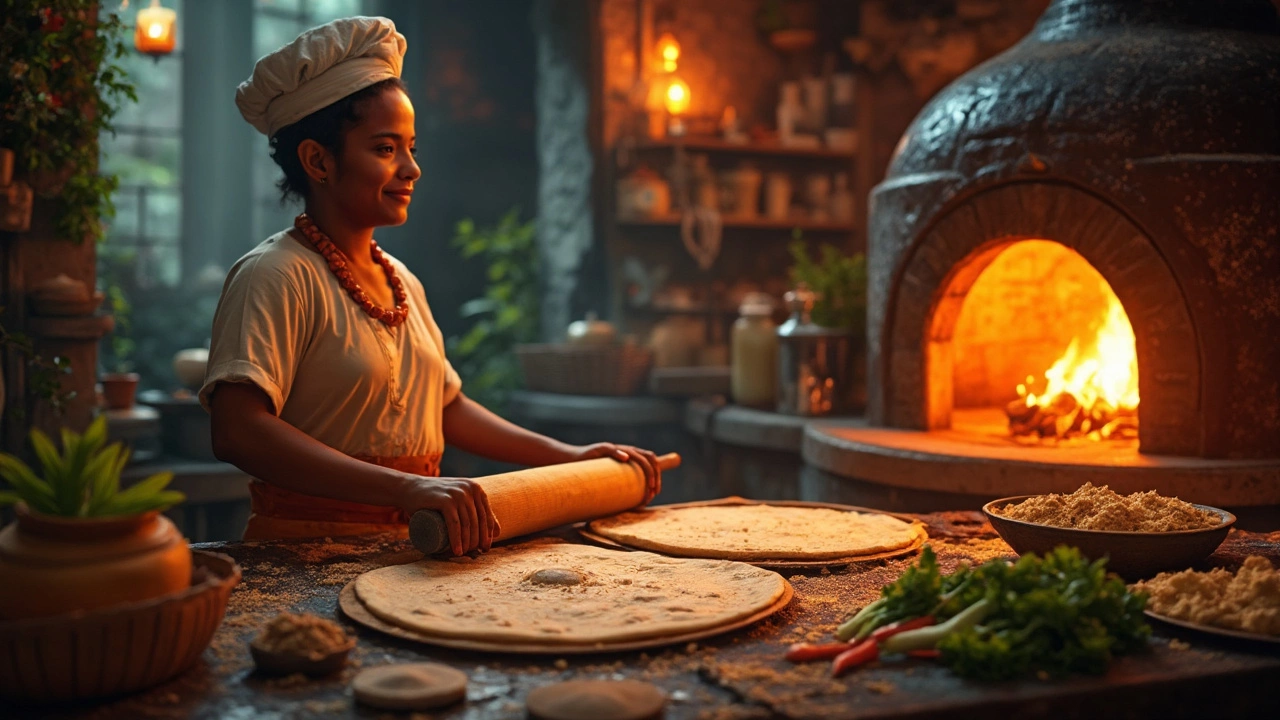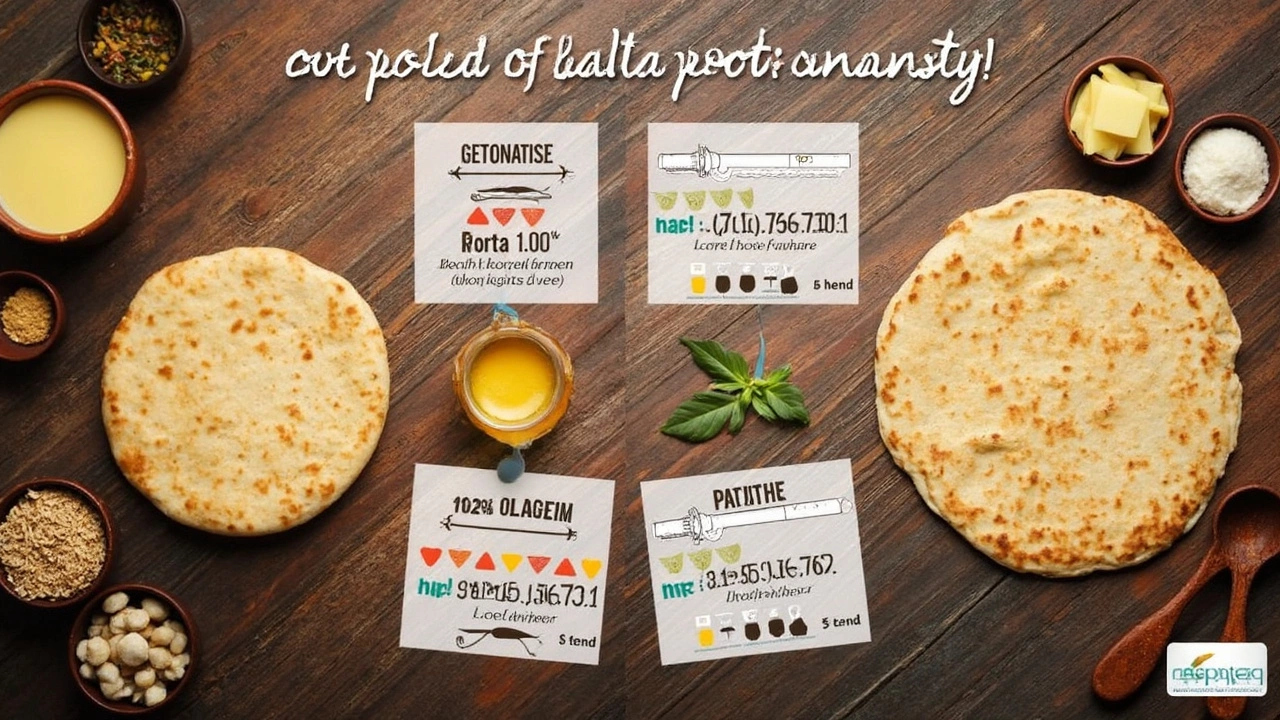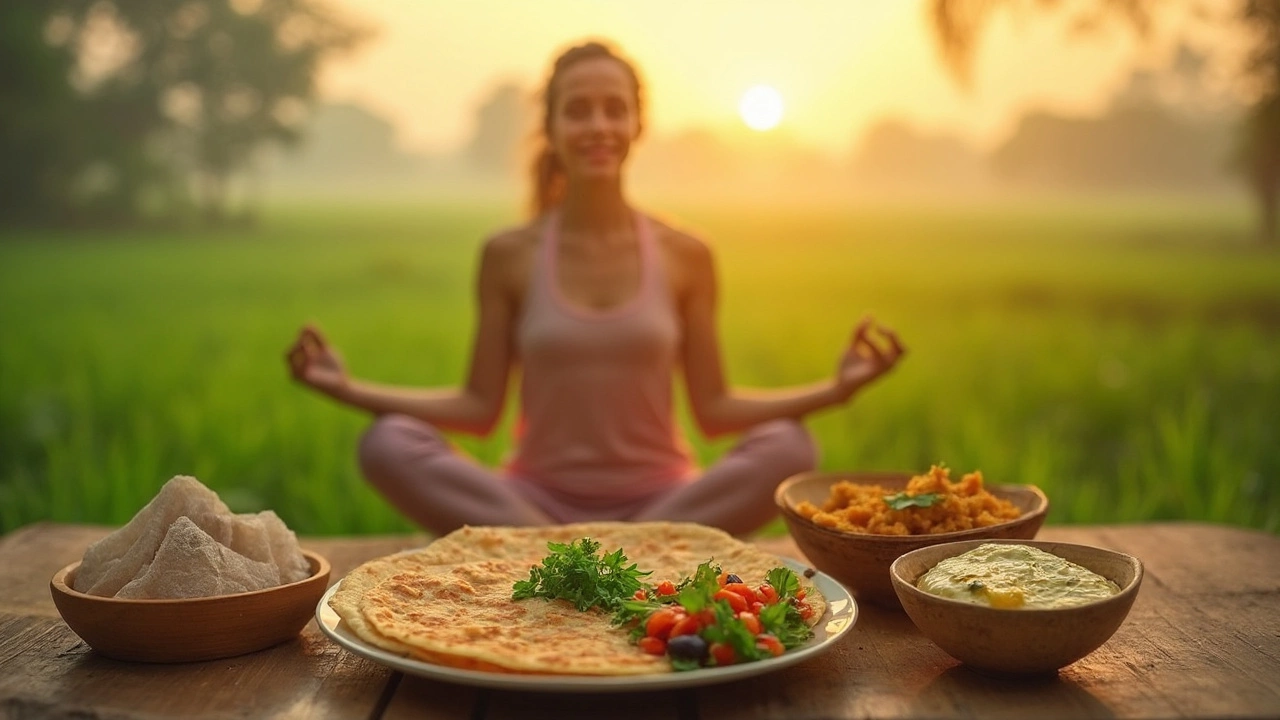Calories in Roti vs. Paratha: What's the Difference?
 Feb, 23 2025
Feb, 23 2025
Roti and paratha, two beloved types of Indian bread, are staples in many homes—and they're delicious, no doubt about it! But if you're watching your diet, understanding how they differ calorie-wise might be just the piece of info you need. Knowing how much calories in 1 roti can help you plan meals better and stay on top of your nutritional goals. It might surprise you how these similar-looking breads stack up against each other in terms of calorie content!
Let's get into the nitty-gritty. A plain roti, which many of us enjoy daily, holds about 70-100 calories, depending on its size and thickness. Now, add some sabzi into the mix, and you're looking at approximately 200-300 calories for a satisfying meal. If you love to add a touch of ghee to your roti, then the numbers jump a bit, as 1 roti with ghee can hit around 130-150 calories.
Comparatively, a paratha is known to be the more indulgent choice, thanks to its preparation style. Generally, how many calories in 1 paratha varies significantly, but it typically ranges from 180-350 calories per serving, depending on whether it's plain, stuffed, or made with whole wheat. So, if you're keen on keeping those calories in check, moderating your paratha intake might be wise!
- Introduction to Roti and Paratha
- Calories in 1 Roti
- Calories in 1 Paratha
- Nutritional Comparisons
- Healthy Tips for Enjoying Roti and Paratha
Introduction to Roti and Paratha
Alright, let's dive into the world of roti and paratha, two essentials of Indian cuisine that have their own fan clubs! These breads, while similar in appearance, bring different flavors and textures to the table.
What is Roti?
Starting with the roti, it's your everyday flatbread made from stoneground wholemeal flour, known as atta. Roti is traditionally cooked on a flat griddle called a tawa and is a staple in almost every Indian household—often eaten plain with veggies, lentils, or curries. This humble bread is celebrated for its health benefits and simplicity, packing fewer calories compared to its richer cousin, the paratha.
Roti is quite adaptable, easily becoming a vegan favorite by keeping it ghee-free. Curious how it's made? Well, the trick lies in its simplicity. Mix atta with water to form a dough, roll it out thin, and cook it on the tawa. Voilà! A fresh roti is ready to be enjoyed. This straightforward preparation keeps the calories in 1 roti relatively low, around 70-100 for an average-sized piece.
What is Paratha?
Now, enter the paratha. This is a flatter, flakier version with layers, often stuffed with a variety of tasty fillings like potatoes, cauliflower, or paneer. It's commonly pan-fried with ghee or oil, giving it that deliciously crispy texture everyone craves.
Making a paratha involves a bit more art. The dough is similarly prepared, but the layering process, often achieved by folding and flattening the bread repeatedly, is what gives it depth. Then, fill it up if desired, roll, cook, and fry until it turns a golden-brown. The calories naturally ramp up here, with a plain paratha ranging between 180-350 calories, depending on the cooking method and additional fillings.
Roti vs. Paratha: The Choice
The dilemma usually boils down to the nutrients versus taste debate. Roti is the go-to if you're cutting calories, while paratha engages a delightful balance between indulgence and nourishment—perfect for those special days. Both have their place in a balanced diet, so enjoy them wisely!
Understanding these basics can help you make informed dietary choices, helping to maintain your health goals while savouring your meals. So whether it's the everyday goodness of roti or the treat-like paratha, now you know what you're getting into with each bite!
Calories in 1 Roti
Curious about the calories in 1 roti? You're not alone. For many of us, roti is a daily companion to our meals, and getting a handle on its calorie count can really help in balancing our diet. Usually, a single roti is around 70 to 100 calories, but that can shift based on size and thickness. Knowing how much calories in 1 roti can make meal planning a breeze.
What Impacts the Calorie Count?
Not all rotis are created equal—portion size, ingredients, and cooking methods can all tweak the calorie tally. Let's break it down:
- Size Matters: A larger roti naturally has more calories—just think of it as more of something awesome.
- Ingredients Matter Too: Whole wheat flour is a popular choice; supplies a hearty texture and essential nutrients. Yet, slipping in millet or quinoa flour could jiggle the calories slightly.
- Cooking Technique: Dry roasting versus using ghee or oil not only impacts taste but also calorie count. A roti brushed with ghee will obviously offer a richer profile.
Tackling the Calorie Puzzle
If you're trying to keep an eye on calorie intake, don't worry—I've got you covered:
- Opt for measuring the flour, so each roti maintains consistent calorie content.
- Limit the use of added fats like ghee, especially if you're indulging frequently.
- Balance your plate by pairing roti with plenty of veggies or proteins, creating a filling yet wholesome meal.
So, while those seeking to slim down might consider moderating their portion or altering preparation methods, remember that roti can still be a part of a nutritious, balanced diet. Embrace healthy, homemade roti as part of your meals, and see how it fits into your daily lifestyle. That summarizes calories in 1 roti effectively for those calorie-conscious food enthusiasts out there.

Calories in 1 Paratha
So, what's the story with parathas and their calorie count? It's pretty interesting! Parathas are known for their flavorful and rich texture, mainly because they are cooked with generous amounts of oil or ghee. That indulgence makes them delicious but also increases their calorie count.
Understanding the Variations
When it comes to calories in paratha, it really varies with how they're prepared. Here's a quick breakdown:
- Plain Paratha: Packs around 180-220 calories.
- Aloo (Potato) Stuffed Paratha: Can go up to 300-350 calories because of the filling.
- Paneer (Cheese) Stuffed Paratha: Typically has about 250-300 calories, but boy, is it tasty!
As you can see, the stuffing adds its own caloric twist. And, the size and amount of ghee used will also tip the scale further. Understanding these factors helps if you're keen on keeping those extra calories in check.
Making Healthier Choices
Don’t worry, you can still enjoy parathas without the guilt! Here are some tips to manage those calories smartly:
- Opt for a whole wheat paratha instead of refined flour—it’s healthier and brings down calorie intake.
- Use less oil or consider using oil sprays to keep the taste but cut down on fats.
- Pair a smaller paratha with a bigger portion of salad for a satisfying meal.
Visual Calorie Comparison
Having a visual can help understand these differences better. Check this simple table:
| Type of Paratha | Calories |
|---|---|
| Plain Paratha | 180-220 |
| Aloo Stuffed Paratha | 300-350 |
| Paneer Stuffed Paratha | 250-300 |
Don't forget, moderation is essential. These calorie insights are here to help guide you in making informed choices without missing out on the flavors you love!
Nutritional Comparisons
When it comes to choosing between roti and paratha, their nutritional profiles offer some insights that could make your decision easier. Let's take a closer look at what you're really getting when you enjoy these popular foods.
Macronutrient Breakdown
Roti is often seen as the healthier choice due to its simpler preparation. Primarily made from whole wheat flour, it packs in more fiber, which is great for digestion. A typical roti includes about 3-4 grams of protein, essential for muscle growth and repair.
On the other hand, parathas are a tad richer in fats. Made with oil or ghee layered between the dough, they add more calories but also more flavor. A single paratha can have approximately 7-10 grams of fat compared to roti's 1 gram.
Glycemic Impact
If you're mindful of your blood sugar levels, understanding the glycemic index (GI) of these breads is crucial. Roti is lower on the GI scale due to its whole grain content, providing a slower release of energy, which helps maintain stable glucose levels.
Paratha, particularly those made with refined flour, may spike blood sugar faster due to a higher GI score, which is something to consider for diabetics or individuals managing insulin sensitivity.
Calorie Counts
Comparatively, calories in roti and paratha calories differ significantly. As mentioned earlier, plain rotis generally have around 70-100 calories, while parathas range from 180-350 calories, depending on ingredients like fillings and oils used.
| Nutrient | Roti (per serving) | Paratha (per serving) |
|---|---|---|
| Calories | 70-100 | 180-350 |
| Protein | 3-4g | 2-3g |
| Fat | 1g | 7-10g |
So, how do you decide what's best for you? It largely depends on your dietary goals. If you're focusing on weight loss or managing diabetes, sticking with roti might be the way to go. Alternatively, if you're after flavor and can afford a higher calorie intake, treating yourself with a paratha here and there is perfectly fine!
Finding a balance is key. Consider combining both in your diet but watch the portions and pair them with vegetables and proteins for a balanced meal. This way, you enjoy the best of both worlds!

Healthy Tips for Enjoying Roti and Paratha
Let's face it, roti and paratha are not just food; they're an essential part of our culinary culture. But hey, if you're trying to keep things healthy, there's still a way to enjoy them without piling on the calories!
Choose Whole Wheat
First up, always opt for whole wheat when making or buying roti and paratha. Whole wheat flour is packed with nutrients and keeps you full longer, perfect for managing portion sizes and reducing overall calorie intake. That way, you maximize nutritional benefits without missing out on taste!
Watch the Oil and Ghee
We get it—ghee makes everything delicious, but moderation is key. Instead of brushing your roti with ghee, try using it sparingly or choosing healthier oils. For paratha, use as little oil as possible to reduce calories, or try baking them instead of frying. It's a small change that makes a big difference!
Balance with Protein and Veggies
Pairing your roti with a protein-rich sabzi not only makes your meal more satisfying but also keeps you from reaching for more carbs later. Consider incorporating lentils or chickpeas for protein, along with a variety of colorful veggies to load up on nutrients. A nourishing balance can work wonders!
“Enjoy traditional foods, but in measured amounts and balanced with physical activity.” – Dietitian Naini Setalvad
Consider Stuffed or Multigrain Options
If plain isn't your style, consider going for stuffed rotis like methi or spinach versions, which naturally provide more fibers and minerals. Multigrain flour can be another excellent choice.
As always, approach your meals with mindfulness. Savor each bite, and don't rush. You'll find that you feel more satisfied even with less on your plate.
Portion Control and Mindfulness
Speaking of portions, keep an eye on how many you serve yourself. Instead of two large parathas, try having one with a side salad. It’s a trick that ensures you get the fullness without the guilt!
So go ahead, enjoy your roti and paratha, but do it smartly. After all, life is too short to skip the food we love, right? Hope these healthy tips help you relish every bite without overthinking the calories!